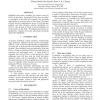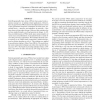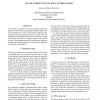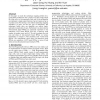ERSA
2006
14 years 25 days ago
2006
Current FPGAs are heterogeneous partially reconfigurable architectures, consisting of several resource types, e. g., logic cells and embedded memory. By using partial reconfigurat...
FPL
2008
Springer
14 years 1 months ago
2008
Springer
Reliability and process variability are serious issues for FPGAs in the future. Fortunately FPGAs have the ability to reconfigure in the field and at runtime, thus providing oppor...
FPL
2008
Springer
14 years 1 months ago
2008
Springer
Field-Programmable Gate Arrays (FPGAs) have gained wide acceptance among low- to medium-volume applications. However, there are gaps between FPGA and custom implementations in ter...
ECOOP
2008
Springer
14 years 1 months ago
2008
Springer
Abstract. The paradigm shift in processor design from monolithic processors to multicore has renewed interest in programming models that facilitate parallelism. While multicores ar...
FPL
2009
Springer
14 years 2 months ago
2009
Springer
In this paper we discuss how various design components perform in both FPGAs and standard cell based ASICs. We also investigate how various common FPGA optimizations will effect t...
ARC
2010
Springer
14 years 2 months ago
2010
Springer
High-Performance Reconfigurable Computers (HPRCs) are parallel machines consisting of FPGAs and microprocessors, with the FPGAs used as co-processors. The execution of parallel app...
FPL
1995
Springer
14 years 3 months ago
1995
Springer
Abstract. FPGAs have been proposed as high-performance alternatives to DSP processors. This paper quantitatively compares FPGA performance against DSP processors and ASICs using ac...
FPGA
2000
ACM
14 years 3 months ago
2000
ACM
In this paper, we study the technology mapping problem for a novel FPGA architecture that is based on k-input single-output PLA-like cells, or, k/m-macrocells. Each cell in this a...
FPGA
2004
ACM
14 years 3 months ago
2004
ACM
Field Programmable Gate Arrays (FPGAs) are an increasingly popular choice of platform for the implementation of cryptographic systems. Until recently, designers using FPGAs had le...
ICCAD
1998
IEEE
14 years 3 months ago
1998
IEEE
Field programmable gate arrays (FPGAs) are commonly used in embedded systems. Although it is possible to reconfigure some FPGAs while an embedded system is operational, this featu...





